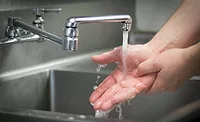It's a food plant, not a garage

Perhaps nowhere is the old adage "a place for everything and everything in its place" more applicable. In the shop, there is a great potential for cross-contamination, especially if maintenance people aren't cognizant of the dangers. Processors who follow that old saying will be much less prone to problems.
The first step is to mandate that the maintenance staff keep the shop clean and well-organized. Lubricant storage is an excellent place to start. Every plant says it only uses food grade lubricants in areas where food is processed and on equipment that is used to process or move food. Yet, when food grade and non-food grade lubricants are stored together in similar containers, you increase the chances for cross-contamination and the likelihood that the incorrect lubricant may be used. Efforts should be made to store these products in separate areas and to clearly delineate which products are food grade and which are not. Some processors color code grease guns, while others use distinctive containers.
Likewise, tools must be used properly and for their intended applications to eliminate potential contamination risks. One simple way to accomplish this is to store tools in the vicinity of where they will be used. Of course, storing tools in a plant can create other problems. They could get lost or they might be removed. Some processors store the tools in lock boxes to which only maintenance people have access. I have even seen operations where the tools are hung in locked storage units with clear, unbreakable plastic covers. Only managers and maintenance staff have access to the boxes. The clear covers allow management to be sure the tools are properly stored.

Finally, don't overlook the maintenance staff. More operators are providing plant workers and managers with smocks, lab coats or uniforms that minimize the potential for product contamination. The clothing is designed with snaps or Velcro clasps rather than buttons and has no breast pockets. To further prevent the chance of cross-contamination, you may want to establish changing rooms between raw and cooked food areas.
Each and every processor needs to take the appropriate steps to protect product. This includes providing the workforce with the tools and support to properly do the job. An organized maintenance shop may not be the first safety concern that comes to mind, but in food production where and how your maintenance staff parks tools and equipment can be the key to improving plant safety.
Looking for a reprint of this article?
From high-res PDFs to custom plaques, order your copy today!




